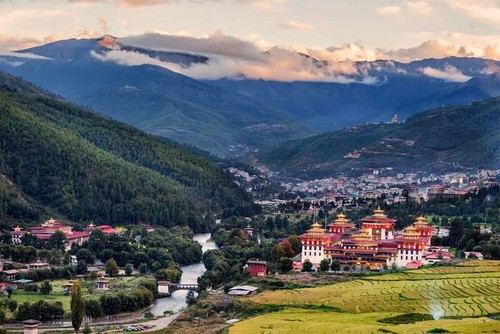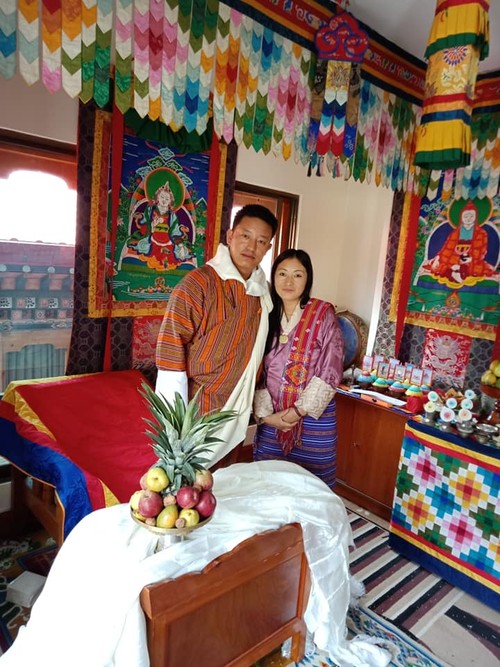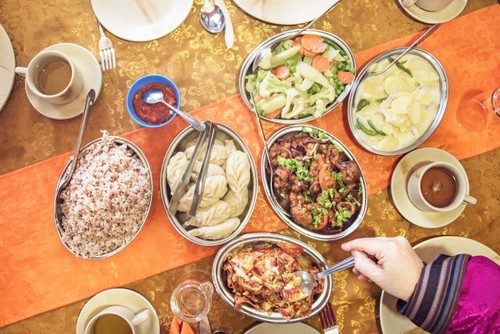 Needrup Zangpo lives in Thimphu, Bhutan's capital, and is the Bhutan Media Foundation's Executive Director. Needrup Zangpo lives in Thimphu, Bhutan's capital, and is the Bhutan Media Foundation's Executive Director. |
Ngoc Diep: Thank you for joining us today, Needrup. While Bhutan is one of the smallest countries in the world, its cultural diversity and richness are profound. First up, can you brief us about Bhutan’s history and development?
Needrup Zangpo: Thank you for having me today. Most Bhutanese refer to their homeland as Druk-yul (Land of the Thunder Dragon), the original and still official name. The country came to be known as DrukYul sometime in the 17th century. The name refers to the Drukpa sect of Buddhism that has been the dominant religion in the region since that period. Initially, Bonism (a pre-Buddhist religion of Tibet) was the dominant religion in the region that would come to be known as Bhutan.Buddhism was introduced to Bhutan in the 7th century. His Majesty Ugyen Wangchuck became Bhutan’s first hereditary King in 1907 and set up the Wangchuck Dynasty that still rules today.
In 2008 Bhutan enacted its Constitution and converted to a democracy in order to better safeguard the rights of its citizens. Later in November of the same year, the current reigning 5th Druk Gyalpo Jigme Khesar Namgyel Wangchuck was crowned.
 Bhutan's capital Thimphu. (Photo: Britannica.com) Bhutan's capital Thimphu. (Photo: Britannica.com) |
Ngoc Diep: You speak perfect English. What is the official language of Bhutan and how many languages are spoken there?
Needrup Zangpo: Thank you. Bhutan is linguistically diverse with over nineteen dialects spoken across the country. The richness of the linguistic diversity can be attributed to the country’s difficult geographical terrain with high mountain passes and deep valleys, which forced the inhabitants of the country to live in isolation before the arrival of modern route. The national language of Bhutan is called Dzongkha, the native language of the western part of the country. Dzongkha literally means the language spoken in the Dzongs, massive fortresses that serve as the administrative centres and monasteries. Besides Dzongkha, English is widely spoken in Bhutan for official correspondence as well as medium of instruction.
 Needrup Zangpo and his wife in Bhutan's traditional attire. Needrup Zangpo and his wife in Bhutan's traditional attire. |
Ngoc Diep: Now I know why many young Bhutanese speak perfect English. I saw a nice photo of your family in traditional clothes on Facebook. They look very beautiful and unique. Please tell us more about Bhutanese’s traditional dress!
Needrup Zangpo: In Bhutan, men wear the Gho, a knee-length robe, somewhat resembling a kimono that is tied at the waist by a traditional belt known as Kera. The pouch, which forms at the front, was used for carrying food bowls and a small dagger. Today however it is more accustomed to carrying small articles such as wallets, mobile phones and Doma (beetle nut).
Ngoc Diep: How about the women?
Needrup Zangpo: Women wear the Kira, a long, ankle-length dress accompanied by a light outer jacket known as a Tego with an inner layer known as a Wonju.
However, tribal and semi-nomadic people like the Bramis and Brokpas of eastern Bhutan generally wear clothing that is quite different from the rest of the Bhutanese population. The Brokpas and the Bramis both wear dresses woven either out of Yak or Sheep hair.
Ngoc Diep: I saw many photos about Bhutan and noticed that Bhutanese often wear long scarves. Is that also a special tradition of the Bhutanese?
Needrup Zangpo: That’s correct. Bhutanese often wear long scarves called Kabneywhen visiting Dzongs, temples and formal places. The scarves worn vary in color, signifying the wearer’s status or rank. Women wear much shorter scarf called Rachus, which is hung over the shoulder and like the Kabney, the Rachus’ color also signifies the rank of the wearer. Rachus are usually woven out of raw silk and embroidered with beautiful rich patterns.
Ngoc Diep: Oh that’s so beautiful. Now a question about Bhutan’s cuisine. What’s so special about Bhutan’s food?
Needrup Zangpo:The most distinctive characteristic of Bhutanese cuisine is its spiciness. Chillis are an essential part of nearly every dish and are considered so important that most Bhutanese people would not enjoy a meal that was not spicy.
Rice forms the main body of most Bhutanese meals. It is accompanied by one or two side dishes consisting of meat or vegetables. Pork, beef and chicken are the meats that are eaten most often. Vegetables commonly eaten include Spinach, pumpkins, turnips, radishes, tomatoes, river weed, onions and green beans. Grains such as rice, buckwheat and barley are also cultivated in various regions of the country depending on the local climate.
 While you are in Bhutan, you will eat a whole lot of cheese and spice. While you are in Bhutan, you will eat a whole lot of cheese and spice. |
Ngoc Diep: Can you name some popular dishes of Bhutan?
Needrup Zangpo: Sure. Some of the most popular Bhutanese dishes include: EmaDatshi, Momos, PhakshaPaa, JashaMaru, and Red Rice.
Ema Datsh is the National Dish of Bhutan. A spicy mix of chilies and the delicious local cheese known as Datshi. This dish is a staple of nearly every meal and can be found throughout the country. Variations on Ema Datshi include adding green beans, ferns, potatoes, mushrooms or swapping the regular cheese for yak cheese.
Momos, these Tibetan-style dumplings are stuffed with pork, beef or cabbages and cheese. Traditionally eaten during special occasions, these tasty treats are a Bhutanese favourite.
PhakshaPaa is Pork cooked with spicy red chillis. This dish can also include Radish or Spinach.
 Ema Datshi, considered a top among the traditional Bhutanese dishes, is made out of cheese and perpendicularly sliced red or green chilly. (Photo: blog.thomascook.in) Ema Datshi, considered a top among the traditional Bhutanese dishes, is made out of cheese and perpendicularly sliced red or green chilly. (Photo: blog.thomascook.in) |
Ngoc Diep: Sounds very delicious. In 2011, the UN General Assembly passed a resolution urging member nations to follow the example of Bhutan’s Gross National Happiness index, calling happiness a "fundamental human goal”. So what does the Gross National Happiness index mean?
Needrup Zangpo: Gross National Happiness (GNH) is the development philosophy of Bhutan, founded by the 4th King of Bhutan, his Majesty Jigme Singye Wangchuck, who said that GNH is more important than GDP, meaning achieving happiness is more important than materialistic growth. GNH envisions holistic development rather than just development. It said that the holistic development should include four pillars: socio-economic development, good governance, conservation of environment, and preservation of cultural and spiritual values. Such development will bring happiness. Economic development alone does not bring happiness, therefore it is limited. So this is briefly about GNH.
Ngoc Diep: Thank you so much, Needrup, for your interesting talk about Bhutan’s unique culture and its development philosophy of Gross National Happiness!